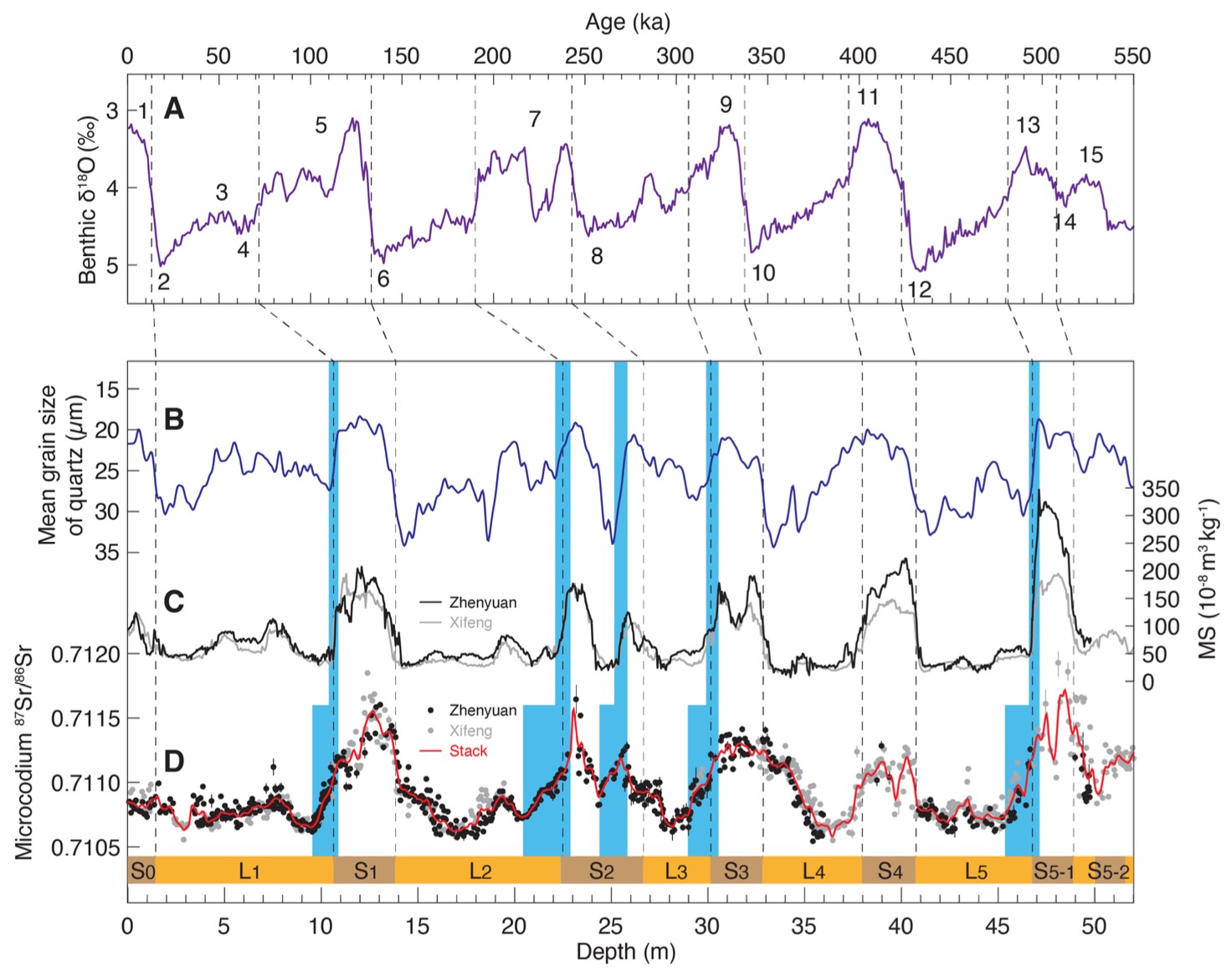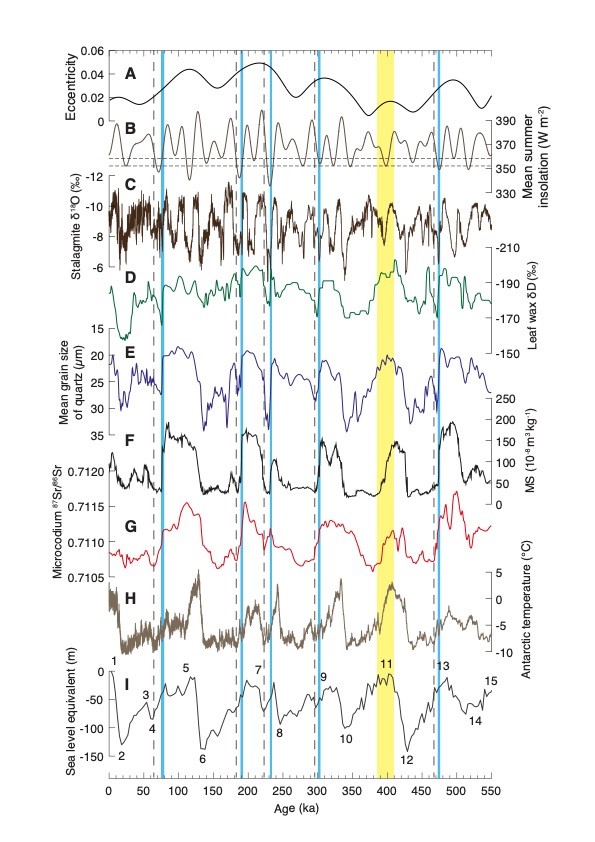The East Asian winter monsoon (EAWM), a major component of the East Asian monsoon circulation, is characterized by prevailing low-level northwesterly winds tightly linked to the high-northern-latitude climate via the Siberian-Mongolian High. Our current understanding of the EAWM dynamics during the glacial-interglacial cycles is mostly based on loess records on the Chinese Loess Plateau (CLP), which suggest that the EAWM intensity is closely linked to the volume of the Northern Hemisphere ice sheets (NHIS) on orbital timescale.
However, unlike the "sawtooth" pattern of global ice volume that shows a gradual build-up of the ice sheets (in ~90000 years) followed by rapid deglaciation (in ~10000 years) since the middle Pleistocene transition as documented by the benthic δ18O records, the loess records of EAWM show distinct glacial and interglacial modes, with the transitions between them generally being quick. This dissimilar evolution pattern between the EAWM and the global ice volume (and NHIS) at the interglacial-glacial transitions means that some key information is missing regarding the dynamics of the EAWM during the glacial inceptions.
Recently, Associate Professor LI Tao from the Nanjing Institute of Geology and Palaeontology, Chinese Academy of Sciences (NIGPAS), in collaboration with Profs. LI Gaojun, CHEN Tianyu, ZHAO Liang, JI Junfeng, CHEN Jun, and Dr. LI Le from Nanjing University, Prof. SUN Youbin and Dr. ZHANG Zeke from the Institute of Earth Environment (CAS), Prof. YIN Qiuzhen and Dr. WU Zhipeng from Université catholique de Louvain, Dr. MENG Xianqiang from Nanjing Institute of Geography and Limnology (CAS), and Prof. Robinson F. Laura from University of Bristol, carried out a high-resolution secondary carbonate (microcodium) Sr isotope (87Sr/86Sr) study from two loess-paleosol sequences on the central CLP, yielding an independent chronology framework for assessing the evolution and potential forcing mechanisms of the EAWM during glacial inceptions over the last 550,000 years (Fig. 1). The research results were published in the internationally recognized journal Geophysical Research Letters.
Building upon this independent chronology and integrating multi-proxy records, the results offer new insights into the dynamics of the EAWM during glacial inceptions and provide compelling evidence for the millennial-scale teleconnections between the high- and middle-latitudes in terminating the interglacial period in the Northern Hemisphere.
This study provides new secondary carbonate (microcodium) 87Sr/86Sr record and integrates multi-proxy records from the central CLP to reinterpret the response of the EAWM to insolation and ice-sheet forcing during glacial inceptions. Microcodium 87Sr/86Sr record, which captures the global cooling trend at the transition zones between the paleosol layer and the overlying loess layer, provides an independent age control for comparing loess records with other paleoclimatic records during glacial inceptions.
At the mid-way of glacial cooling, abrupt coarsening occurred synchronously with rapid positive shifts in the hydrogen and oxygen isotopic compositions of precipitation, indicating concurrent abrupt shifts in the EAWM and EASM during glacial inceptions (Fig. 2). The gradual declining summer insolation in Northern Hemisphere high-latitudes during glacial inceptions may trigger an abrupt weakening of Atlantic meridional overturning circulation (AMOC) and thus cooling in the northern North Atlantic, which strengthens the Siberian–Mongolian High cell and the EAWM but weakens the EASM.
Nevertheless, the insolation-triggered abrupt weakening of AMOC alone cannot account for the mode shift in the EAWM during glacial inceptions. For example, the δ18O record from the Iberian Margin and the modeling results both indicate a sharp weakening of AMOC at the Marine Isotope Stage (MIS) 5e/5d transition while the loess records show no significant changes in the EAWM from MIS 5e to MIS 5a. This indicates that the gradual build-up of the NHIS may have played an important role in preconditioning the rapid, coupled shifts in the EAWM and EASM at during the glacial inceptions.
The key role of NHIS in modulating the insolation-triggered abrupt changes in the EAWM at the end of interglacial is further supported by the absence of an abrupt shift in the EAWM at the MIS 11/10 transition when the build-up of NHIS is delayed due to the eccentricity minima.
"Our results thus provide compelling evidence for the nonlinear response of the EAWM to ice volume and insolation forcing during the interglacial-glacial transitions", says LI.
This research was supported by the National Natural Science Foundation of China, the Strategic Priority Research Program of the Chinese Academy of Sciences.
Reference: Li, T., Li, G.*, Chen, T., Sun, Y., Yin, Q., Wu, Z., Robinson, L.F., Li, L., Zhang, Z., Meng, X., Zhao, L., Ji, J., Chen, J., 2023. Ice Volume and Insolation Forcing of Abrupt Strengthening of East Asian Winter Monsoon During Glacial Inceptions. Geophysical Research Letters 50. https://doi.org/10.1029/2022GL102404.

Fig. 1 Proxy variations of Xifeng and Zhenyuan loess sequences compared to the LR04 benthic δ18O stack.

Fig. 2 Comparison of loess proxy records with other paleoclimatic records over the last 550,000 years.
Contact:
LIU Yun, Propagandist
Email: yunliu@nigpas.ac.cn
Nanjing Institute of Geology and Palaeontology, Chinese Academy of Sciences
Nanjing, Jiangsu 210008, China
Download:
